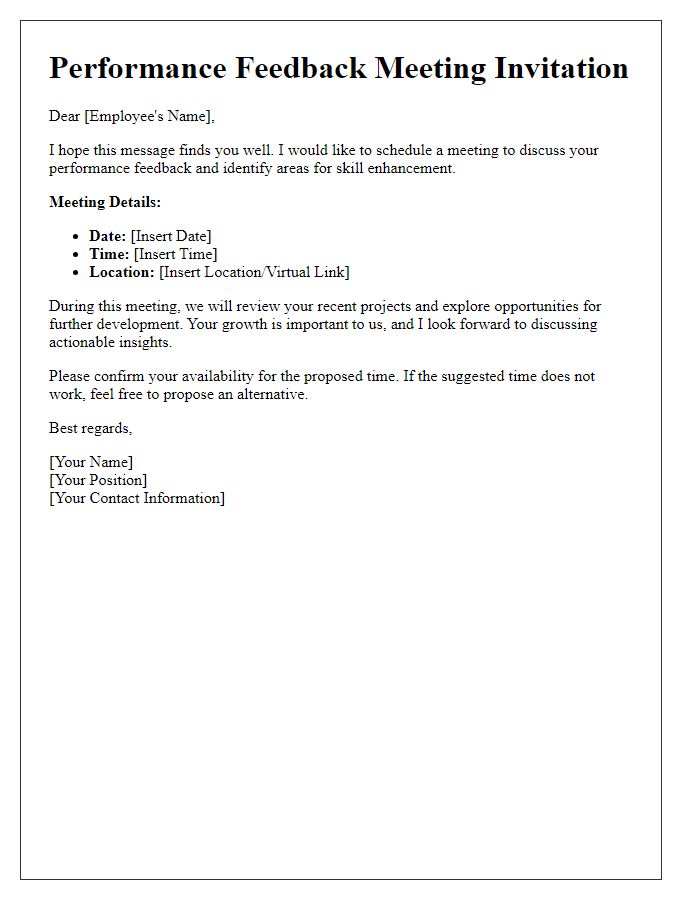Are you gearing up for your employee performance appraisal discussions? These conversations are essential for fostering growth and ensuring that both the employee and organization are aligned in their goals. Crafting an effective letter for this purpose can set the tone for productive dialogue and meaningful feedback. So, let's dive in and explore some key elements that will make your performance appraisal letter stand outâread on to discover more!

Introduction and purpose of the appraisal
The employee performance appraisal serves as a structured evaluation process aimed at assessing job performance, setting future goals, and identifying opportunities for professional development. This discussion typically occurs annually, providing both the employee and management an opportunity to reflect on achievements, challenges, and growth within the organization. The appraisal aims to align individual performance with company objectives, enhance communication between employees and supervisors, and foster a culture of continuous improvement. These evaluations commonly utilize specific metrics and feedback mechanisms to ensure a comprehensive understanding and constructive dialogue.
Summary of the employee's achievements
During the performance appraisal period, the employee has surpassed expectations in multiple key areas. Notably, the individual successfully completed a project that increased team efficiency by 30%, demonstrating exceptional project management skills. Customer satisfaction ratings improved from 75% to 90% due to the employee's implementation of a new feedback system, enhancing client engagement and service responsiveness. Additionally, the employee took the initiative to lead a training workshop for seven team members, fostering skill development and collaboration within the department. These achievements have significantly contributed to the overall objectives of the company, showcasing the employee's dedication and strong work ethic.
Areas for improvement and development
During the employee performance appraisal, key areas for improvement and development can be assessed to enhance workplace effectiveness. Time management skills can be refined, especially in roles requiring project coordination and meeting deadlines (for instance, in industries like marketing, where timely campaign launches are crucial). Communication abilities can be developed for clearer interactions among team members and departments. This can include improving verbal presentation skills for department meetings or written communication for email correspondence. Furthermore, technical skills relevant to specific software tools--such as Microsoft Excel for data analysis, or Customer Relationship Management (CRM) systems like Salesforce for better client interaction--can be targeted for improvement. Identifying opportunities for professional development, such as workshops or mentorship programs, can also foster employee growth and enhance overall team performance.
Goals and objectives for the upcoming period
During performance appraisal discussions, setting clear goals and objectives for employees is crucial for their development and alignment with organizational strategy. For instance, a sales representative might aim to increase quarterly sales by 15% through targeted marketing campaigns, while a project manager could focus on completing upcoming projects within budget and ahead of schedule, using agile methodologies. Specific professional development objectives, like attaining a certification in project management (PMP) or enhancing technical skills in data analysis (using SQL or Python), can provide measurable pathways for success. Regular check-ins, such as monthly performance reviews, can help track progress regarding these goals, ensuring continuous feedback and support from team leaders. Such frameworks not only foster employee growth but also contribute to a more robust organizational performance matrix.
Closing remarks and next steps
Employee performance appraisal discussions serve as pivotal moments in professional development. Closing remarks need to emphasize key achievements noted throughout the evaluation period, acknowledging specific contributions to projects or team dynamics. Targets set during these discussions should be clearly articulated, focusing on measurable goals for the upcoming performance cycle. Clear next steps include scheduling follow-up meetings (for instance, quarterly reviews) to assess progress towards these goals. Documentation of the appraisal should be consolidated within performance management systems to ensure easy access and reference for future evaluations. Constructive feedback mechanisms should be established to foster continued growth and career advancement opportunities, creating a supportive environment for both personal and professional development.
Letter Template For Employee Performance Appraisal Discussion Samples
Letter template of employee evaluation talk for professional development













Comments